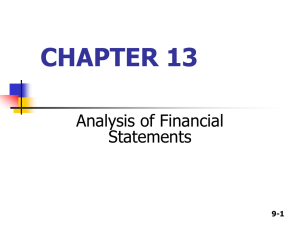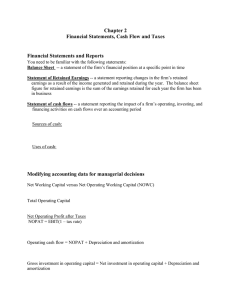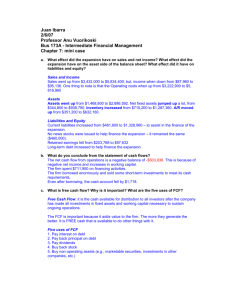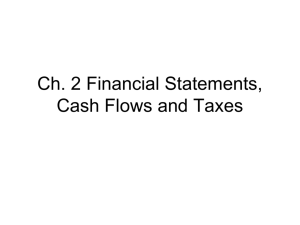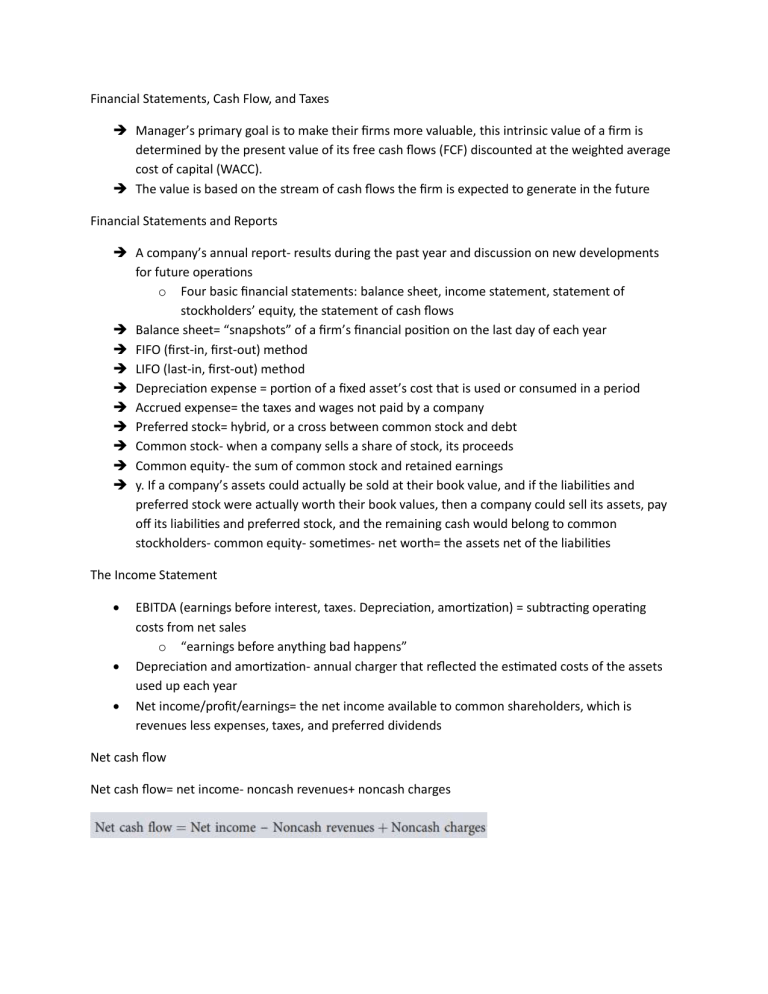
Financial Statements, Cash Flow, and Taxes Manager’s primary goal is to make their firms more valuable, this intrinsic value of a firm is determined by the present value of its free cash flows (FCF) discounted at the weighted average cost of capital (WACC). The value is based on the stream of cash flows the firm is expected to generate in the future Financial Statements and Reports A company’s annual report- results during the past year and discussion on new developments for future operations o Four basic financial statements: balance sheet, income statement, statement of stockholders’ equity, the statement of cash flows Balance sheet= “snapshots” of a firm’s financial position on the last day of each year FIFO (first-in, first-out) method LIFO (last-in, first-out) method Depreciation expense = portion of a fixed asset’s cost that is used or consumed in a period Accrued expense= the taxes and wages not paid by a company Preferred stock= hybrid, or a cross between common stock and debt Common stock- when a company sells a share of stock, its proceeds Common equity- the sum of common stock and retained earnings y. If a company’s assets could actually be sold at their book value, and if the liabilities and preferred stock were actually worth their book values, then a company could sell its assets, pay off its liabilities and preferred stock, and the remaining cash would belong to common stockholders- common equity- sometimes- net worth= the assets net of the liabilities The Income Statement EBITDA (earnings before interest, taxes. Depreciation, amortization) = subtracting operating costs from net sales o “earnings before anything bad happens” Depreciation and amortization- annual charger that reflected the estimated costs of the assets used up each year Net income/profit/earnings= the net income available to common shareholders, which is revenues less expenses, taxes, and preferred dividends Net cash flow Net cash flow= net income- noncash revenues+ noncash charges Noncash charges= depreciation and amortization (largest noncash items), deferred taxes Net cash flow= net income = depreciation and amortization (it will not accurately reflect the net cash flow when there are significant noncash items than depreciation and amortization) Statement of cash flows - Even if a company reports a large net income during a year, the amount of cash reported on its year-end balance sheet may be the same or even lower than its beginning cash The company’s cash position is affected by: 1. Net income before preferred dividends: a positive net income => more cash in the bank 2. Noncash adjustments to net income: to calculate cash flow, necessary to adjust net income to reflect noncash revenues and expenses, such as depreciation and deferred taxes 3. Changes in working capital: increases in current assets other than cash (inventories, accounts receivable) decrease cash, whereas decreases in these accounts increase cash a. increases in current liabilities such as accounts payable increase cash, whereas decreases in current liabilities decrease cash 4. Investments: if a company invests in fixed assets or short-term financial investments, this will reduce its cash position; if it sells some fixed assets or short-term investments, this will increase cash 5. Security transactions and dividend payments: if a company issues stock or bods during the year, the funds raised will increase its cash position All of them- reflected- statement of cash flows- summarizes the changes in a company’s cash position 1. Operating activities- net income, depreciation, changes in current assets and liabilities other than cash, short-term investments and short-term debt 2. Investing activities- investments in or sales of fixed assets and short-term financial investments 3. Financing activities- raising cash by issuing short-term debt, long-term debt or stock Modifying Accounting Data for Managerial Decisions Accounting profit= a firm’s net income The intrinsic value of a company’s operations is determined by the stream of cash flows that the operations will generate now and in the future Free cash flows (FCF)= after-tax operating profit minus the amount of new investment in working capital and fixed assets necessary to sustain the business The way for managers to make their companies more valuable- increase free cash flow Non Operating Profit after Taxes (NOPAT) = better measurement for comparing managers’ performance (rather than net income), the amount of profit a company would generate if it had no debt and held noo financial assets NOPAT= EBIT(1-Tax rate) Net Operating Working Capital Operating current assets= the short-term assets normally used in a company’s operating activities o Most companies need some cash in its bank account because inflows and outflows do not coincide perfectly Nonoperating assets= short-term investments, excluded when calculating operating current assets Operating current liabilities= liabilities (accounts payable and accruals) which arise in the normal course of operations Net operating working capital (NOWC)- operating current assets minus operating current liabilities, the working capital acquired with investor-supplied funds Total Net Operating Capital In addition to working capital, most companies also use long-term assets to support their operations (land, buildings, factories, equipment) Total net operating capital= NOWC + operating long-term assets Calculating Free Cash Flow Free cash flow- FCF FCF= NOPAT- net investment in operating capital Gross investment= net investment+ depreciation Operating cash flow: Free cash flow in terms of operating cash flow and gross investment in operating capital: The Uses of FCF: FCF= the amount of cash available for distribution to all investors, shareholders and debtholders 1. Pay interest to debtholders, keeping in mind that the net cost to the company is the after-tax interest expense. 2. Repay debtholders; that is, pay off some of the debt. 3. Pay dividends to shareholders. 4. Repurchase stock from shareholders. 5. Buy short-term investments or other nonoperating assets FCF and Corporate Value FCF- the amount of cash available for distribution to investors => o the fundamental value of a company to its investors depends on the present value of its expected future FCFs, discounted at the company’s weighted average cost of capital (WACC) WACC- weighted average cost of capital Evaluating FCF, NOPAT, and Operating Capital Return on invested capital (ROIC) – the ratio of NOPAT (Non Operating Profit after Taxes) to total operating capital o To calculate the ROIC, we first calculate NOPAT and operating capital. The return on invested capital is a performance measure that indicates how much NOPAT is generated by each dollar of operating capital o If ROIC is greater than the rate of return that investors require, which is the weighted average cost of capital (WACC), then the firm is adding value MVA and EVA Market Value Added = the way to calculate the maximization of shareholders’ value (primary goal of most firms), the difference between the market value of the firm’s stock and the equity of capital supplied by shareholders o Measures the effects of managerial action since the very inception of a company Sometimes: defined as the total market value of the company minus the total amount of investorsupplied capital Economic Value Added= focuses on managerial effectiveness in a given year - Can also be calculated in terms of ROIC - a firm adds value—that is, has a positive EVA—if its ROIC is greater than its WACC. If WACC exceeds ROIC, then new investments in operating capital will reduce the firm’s value - when calculating EVA, do not add back depreciation Depreciation= a cost because worn-out assets must be replaced and it is deducted when determining both net income and EVA Economic Value Added- measures the extent to which the firm has increased shareholder value. If managers focus on EVA, this will help to ensure that they operate in a manner that is consistent with maximizing shareholder wealth. Two observations: a. A relationship between MVA and EVA, not direct. If a company has a history of negative EVAs, then its MVA will probably be negative; conversely, its MVA probably will be positive if the company has a history of positive EVAs. Therefore, a company with a history of negative EVAs could have a positive MVA, provided investors expect a turnaround in the future b. When EVAs and MVAs are used to evaluate managerial performance as part of an incentive compensation program, EVA- the measured typically used i. Because it shows the value added during a given year, whereas MVA reflect performance over the company’s entire life ii. EVA can be applied to individual divisions or other units of a large corporation, whereas MVA must be applied to the entire corporation The Federal Income Tax System Corporate Income Taxes The marginal tax rate- the rate paid on the last dollar of income Average tax rate- the average rate paid on all income Interest and Dividends Paid by a Corporation - A firm’s operations can be financed with either debt or equity capital. . If the firm uses debt then it must pay interest on this debt, but if the firm uses equity then it is expected to pay dividends to the equity investors (stockholders) The interest paid by a corporation is deducted from its operating income to obtain its taxable income, but dividends paid are not deductible. Corporate Capital Gains - Taxed at the same rates as their operating income Corporate Loss Carryback and Carryforward - Ordinary corporate operating losses can be carried back (carryback) to each of the preceding 2 years and forward (carryforward) for the next 20 years and thus be used to offset taxable income in those years Improper Accumulation to Avoid Payment of Dividends - Corporations could refrain from paying dividends and thus permit their stockholders to avoid personal income taxes on dividends Tax Code contains an improper accumulation provision that states that earnings accumulated by a corporation are subject to penalty rates if the purpose of the accumulation is to enable stockholders to avoid personal income taxes Consolidated Corporate Tax Returns - If a corporation owns 80% or more of another corporation’s stock, then it can aggregate income and file one consolidated tax return; thus, the losses of one company can be used to offset the profits of another Taxation of Small Businesses: S Corporations Small businesses that meet certain restrictions may be set up as corporations and receve the benefits of the corporate form of organization- limited liability- yet still be atxed as proprietorships or partnerships rather than as corporations- S corporations C corporations- regular corporations Personal Taxes Ordinary income= wages or profits from a proprietorship or partnership, plus investment incme Progressive tax= for those with higher income, the higher one’s income, the larger the percentage paid in taxes Municipals/ munis= interest received from most state and local government bonds Capital assets= stocks, bonds, real estate Capital gain= if you sell the asset for more than originally paid Capital loss= invers
